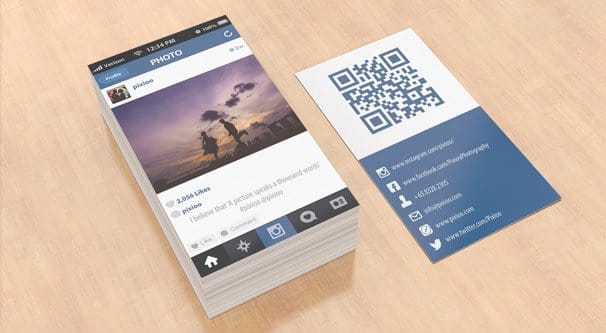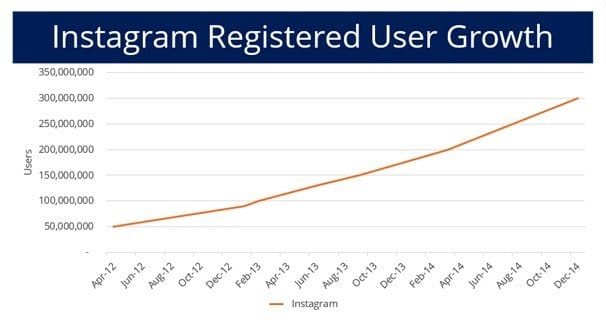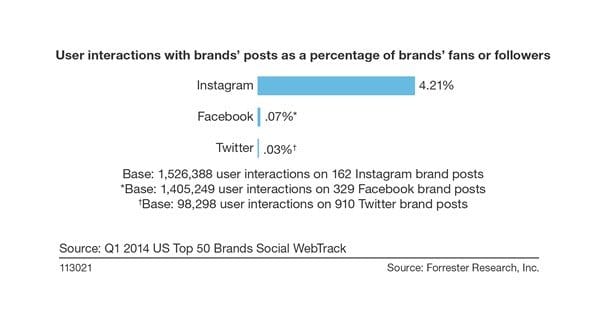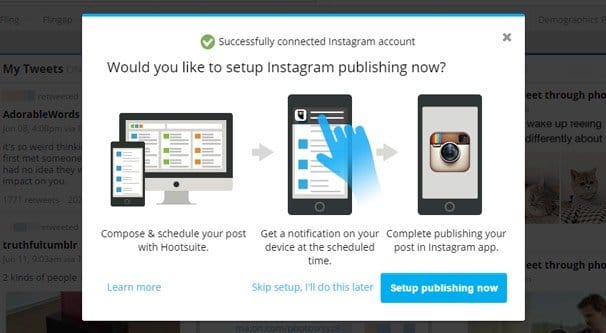 Written by ContentPowered.com
Written by ContentPowered.com
Instagram is something of a notorious platform among marketers. It’s incredibly powerful, for reasons I’ll discuss later, but it’s also hard to use. Up until a couple years ago, you couldn’t even access it via the web, you had to use a mobile app. You still can’t post via the web, unless you use one of a handful of mobile simulator programs. The barrier to entry is high, but the rewards are very much worth it. Here are my personal reasons why every business should join Instagram.
The Feed Isn’t Filtered
Facebook’s feed is notorious for simply not showing your posts to your followers. Something like 6-15% of your users see any individual post, so your audience growing efforts need to be much greater to achieve any significant growth in visibility. For many businesses, it’s a matter of hoping and praying for that viral attention.
Twitter, meanwhile, introduced a curated feed and partially removed one of their biggest draws, which was the uncurated time-based feed. This caused a notable drop in their stock price and a ton of users abandoning it.
Instagram, though, maintains the unfiltered, time-based feed. You see posts in the order they were made, with the most recent posts first. Sure, there’s the occasional sponsored image, but that’s the same on any site. For the most part, though, everyone gets a roughly equal chance to be seen, so long as they keep social media timing in mind. It’s a fair playground for everyone, and it looks to be staying that way, unlike Twitter.
Mobile is Growing Daily
The adoption of mobile devices is slowing, somewhat, but that’s just a slower growth rate, and it’s only because most of the people who want a smartphone by now already have one. That said, it’s still growing, just not at the exponential rate it was when technology increased monthly and there was some new, amazing feature every few weeks.
Meanwhile, Instagram has been steadily growing as well. They’ve seen the same sort of slowdown in growth, but they’re still ahead of both Facebook and Twitter in terms of growth and engagement rates.
Instagram Ranks Well, Particularly in Image Search
Instagram’s web accessibility has made it available to be indexed by Google, and it’s available to be linked to by websites all over the world, so it has become an SEO powerhouse. Links from Instagram are just as valuable as links from other social networks. More importantly, images posted on Instagram rank highly in image searches. This gives you an additional, hard to reach vector for search visibility.
Instagram Engagement is Huge
At the end of 2015, Instagram engagement rates had dropped to “mere” 1.08%. Only one out of every 100 followers likes or comments on your photos. Sound bleak? It’s still easily double what the average brand on Facebook gets, and it’s often 10x higher than what Twitter gets you.
This is a drop, and it applies to most new and less active profiles. Active, engaged Instagram brands can rack up incredibly high engagement rates, 2%, 3%, 5% or higher. It’s frankly amazing, and even if it does mean only a small percentage of your audience is watching, that’s still more than you get elsewhere.
Instagram Influencers are Unique
One thing I see time and time again is that influencers tend to be influencers regardless of platform. Someone powerful and influential in your industry is probably going to be influential on Facebook, on Twitter, on LinkedIn, and on Google+ all pretty much equally. Instagram is different, though. A lot of people use Instagram who don’t care much for other platforms. They might be influencers on Instagram but don’t have a presence on other networks. At the same time, since the barrier to Instagram is so high, relatively few influencers from other platforms exist on Instagram.
What this means is that you have more of an opportunity to become an influencer on the site, due to lower competition. You also have more of an opportunity to connect with existing influencers, because they aren’t inundated with networking requests nearly as much as influencers cross-platform. It’s a matter of opportunities; you simply have more of them on Instagram.
It’s a Larger Site than Twitter
We think of Twitter as this huge social network with tons of activity, and it is. There’s nothing to scoff at when a site has 320 million monthly active users. Then we think of Instagram as this smaller, niche image-focused site sitting on mobile devices, attracting hipsters and children. What we miss is that Instagram has over 400 monthly active users. It’s an enormous site, and it’s still growing at a rate faster than Twitter’s. You can’t scoff at that, either.
It’s Full of Young People
Instagram is growing steadily more popular with adults, but it’s still primarily a platform for young people. 23% of Instagram users are in the 18-24 age range, and an additional 25.6% of them are 25-34. Adults ranging from 35-54 make up 35% of the site’s userbase. Heck, 5% are age 65 or older. This is all as of December 2015.
It’s Excellent for Local Businesses
Since Instagram is a primarily mobile platform, it works very well with hyper-local targeting.
You have very good organic local targeting in addition to paid targeting, and you can easily integrate Instagram with your in-store marketing via QR codes. You can also follow local users and monitor local trends on Instagram to capitalize on opportunities that broader competitors simply can’t.
Businesses are Slow to Adopt
Instagram has a high barrier to entry. If you want to use it, you absolutely must do so via a mobile platform or mobile simulator. There are very few services that allow you to post via Instagram from a desktop platform, and most of those services need your login information, because they’re just a bunch of guys with a bunch of phones and multi-user apps logged in as their clients. You may be able to use something like Bluestacks as a phone emulator, but even that is dicey.
All of this means that businesses are very slow to adopt the site as part of their marketing. Only around 23% of businesses even have an Instagram profile, and fewer keep their profile active or do their marketing well. This means only one in five of your competitors, on average, is going to have a presence on Instagram. This will vary by industry, of course, but even so.
Getting into Instagram and getting involved with your fanbase is a great way to undercut your competitors. You can even use your competitors audiences on something like Facebook to advertise your Instagram page; just target people who like your competitor with the ad.
Visuals are Excellent
A picture is worth 1,000 words, as they say, and Instagram is completely focused on pictures and short videos. Your images can tell stories, they can connect with your users, they can advertise, and so much more. As we know from other platforms, content with images performs far better than content without, universally. Instagram, being completely focused on visuals, gives a certain amount of atmosphere and attention that turn them from an aesthetic and tertiary benefit to a focused following.
The caveat to this is that people are going to be much more critical. You won’t be able to throw up basic images under the assumption that people are really paying attention to the content and that the images are fluff. They take center stage on Instagram, and as a consequence, you’re going to have to get good at taking pictures and editing them to look amazing.
Convinced? I hope so. The rest of this article assumes you’re decided to adopt Instagram and want some tips for getting started.
How to Run a Great Instagram Page
The first thing you’re going to want to do is optimize your profile, your bio, and all of the rest of the static information.
- Your username is fixed, and it’s going to be part of your URL. You can’t change it later, so make sure it matches your brand now.
- Your name is important, as it’s a display name, much like on Twitter. Use it to clarify who you are specifically if you’re a subdivision of a larger company, or to specify your identity without username garbage.
- Make sure to link to your website in your profile. This is the only place you can actually include a link, so I recommend a specific landing page geared towards attracting the mobile users that come in.
- Include a description of who you are and what you do, as well as a personality for your brand. Don’t be afraid to have fun; even stodgy businesses can let their guard down on Instagram. Check out a bunch of good examples here.
Once you have a bio and profile set up, you need to figure out what your style is going to be. What sort of content are you going to post? What fits your brand persona? What fits your personality? Are you going with typographically-focused, classic art? Are you aiming for a more graffiti look? How about an art nouveau slant? Are you focusing on photos of the outdoors or of your product? Are you emphasizing the culture your users are part of? There are as many options as there are brands, so extend your brand persona to its logical visual extreme.
Make sure to set up a plan for how you interact with and engage with your users. When someone comments on a photo, check that comment to see if it’s an opportunity to respond. You never know when you might have a great chance to make a new friend, or push a follower into the realm of “brand advocate.” Sometimes all it takes is acknowledgement. People like to know their brands recognize them as people, rather than just wallets with legs.
Instagram has a lot of analytics you can get, plus there are third party apps you can use to manage and analyze Instagram accounts. Get used to using some kind of analytics and management suite, because let’s face it; working with a mobile app for part of your business strategy can be tedious. You want to really get the details down, and it’s easiest to do that from something like Hootsuite.
Make sure to enhance your images with captions. Don’t just describe the image, add value to it. Explain it, give it context, or build upon it. Tag others if they’re in the photo and have given permission.
As for hashtags, if anything, they’re more important here than on Twitter. You have room for more than you do on Twitter, but you don’t want to go overboard with them. Try to stick with a handful, with a couple of branded tags and a few relevant to the event, location, or subject of the image. Hashtags get you exposure with people who are searching specific types of content, so it’s a great way to feature the subjects of your images.
Instagram is also a great platform for social media contests. You can ask for comments, shares, tags, or mentions easily. Even better, though, you can ask users to submit photos of their own. On Facebook or Twitter, you’re going to get a low response to this sort of contest, because the people there might not have the capability of creating that kind of content. On Instagram, though, you know that everyone is able to take photos, because everyone is a content creator. Everyone is equal on Instagram, you don’t get benefits for having a business account or anything, at least not organically.
Oh, and don’t forget to make sure your account is public. If it’s private, and you have to approve followers, you don’t get much out of it. People don’t want to follow an account if they don’t know what that account posts. They also don’t want to follow an account when they know their own is under review. On top of that, you can’t encourage non-registered users on the web to register, nor can you get your content indexed by search engines. It’s a lose-lose situation.






